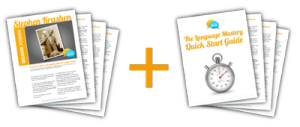Review of Rosetta Stone
With $210,000,000 in sales last year, Rosetta Stone is far and away the best selling language learning product on the market today. But Rosetta Stone’s sales figures say more about the company’s marketing budget than the quality of their products.
A quick look around the web reveals a healthy mix of positive and negative feedback about the product, but there is a big problem with objectivity: the positive reviews tend to be from affiliate sites hoping you click the “Buy” link. Since I don’t sell Rosetta Stone, I figure I can provide an honest, objective review of the product.
Here are my impressions after sampling the free CD-ROM:
The Good
Attractive & Intuitive
As you would expect from a company as large as Rosetta Stone, they offer a well-designed product with an attractive and intuitive interface. High quality images and sound prompts make the product easy to use.
No Translation
The grammar-translation method favored by many traditional schools and textbooks is not an effective way to learn a language and I was glad to see Rosetta Stone avoid this common pitfall. Users infer the meaning of new words through matching images and sounds in highly contextualized groupings.
No Overt Memorization
Although you will “memorize” new words and phrases, Rosetta Stone focuses on sub-conscious internalization of a language, much like the way a child learns their native tongue. Their method mirrors what linguists call “The Natural Approach”.
Spaced Repetition
As you go through a level, the same words are used multiple times in new sentences in progressively longer intervals. This helps speed up internalization and prolong retention.
The Bad
Extremely Expensive
A complete set for one language (e.g.Rosetta Stone Spanish, including levels 1, 2, 3, 4 and 5) has a list price of $700!!! For that price, you could buy a plane ticket to the country where the language is spoken and getreal immersion. Or you could buy premium online subscriptions to dozens of languages instead. (See my recommendations below)
Repetitive
Although Spaced Repetition is effective, it can make the learning process a little boring. My advice is to supplement formal Spaced Repetition with “Narrow Listening” (i.e. listening to a variety of sources discussing the same topics.) This provides adequate repetition without boring you to tears.
Requires Sitting at a Computer
The number one excuse for not studying a foreign language is “I don’t have the time.” My advice to busy people is learning on the go. Using an iPod or portable media player, you can listen to the target language while commuting, waiting in line, doing chores around the house, etc. But since you must be sitting at a computer to use Rosetta Stone, most people will probably not get in the required amount of daily input using their system.
My Verdict
If you have the money and the time,Rosetta Stone is a good choice. Many companies offer their employees subsidies to use Rosetta Stone, and even allow employees to study while at work. Check with your HR or management team to see if they will do the same. But if you are low on money and time (as most people are), I would instead just recommend free podcasts or affordable “freemium” sites.
















